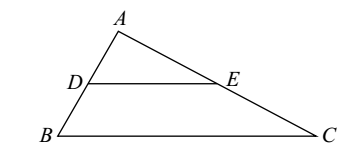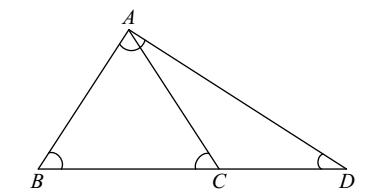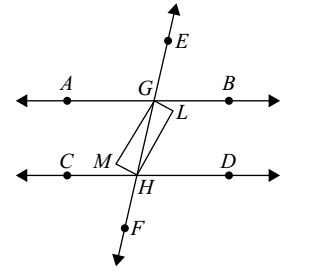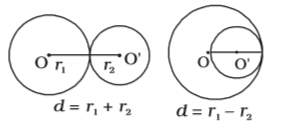Plane Geometry
- In, ΔABC, D and E are the mid-points of AB and AC respectively. Find the ratio of the areas of ΔADE and ΔABC.

-
View Hint View Answer Discuss in Forum
Clearly DE || BC (by converse of BPT)
∴ ΔADE ∼ ABC (∠A = ∠A and ∠ADE = ∠B)∴ Area (∆ADE) = AD2 (Area Theorem) Area (∆ABC) AB2 Correct Option: B
Clearly DE || BC (by converse of BPT) ∴ ΔADE ∼ ABC (∠A = ∠A and ∠ADE = ∠B)
∴ area (∆ADE) = AD2 (Area Theorem) area (∆ABC) AB2 = AD2 = 1 (∴AB = 2AD) (2AD)2 4
- In the given figure, ∠B = ∠C = 55° and ∠D = 25°. Then:

-
View Hint View Answer Discuss in Forum
According to question,
∠B = ∠C = 55° , ∠D = 25°
We can say ,
AB = AC ( ∴ ∠B = ∠C = 55° )
In Triangle ABC,
∠A + ∠B + ∠C = 180°
⇒ ∠A + 55° + 55° = 180°
⇒ ∠A + 110° = 180°
⇒ ∠A = 180° - 110°
⇒ ∠A = 70° ..........................(1)
As per given figure,
∠ACD + ∠ACB = 180° ( ∠ACB = ∠C = 55°)
⇒ ∠ACD + 55° = 180°
⇒ ∠ACD = 180° - 55°
⇒ ∠ACD = 125° ....................... (2)
Now in Triangle ACD,
∠CAD + ∠ACD + ∠CDA = 180°
⇒ ∠CAD + 125° + 25° = 180°
⇒ ∠CAD + 150° = 180°
⇒ ∠CAD = 30° ...........................(3)Correct Option: D
According to question,
∠B = ∠C = 55° , ∠D = 25°
We can say ,
AB = AC ( ∴ ∠B = ∠C = 55° )
In Triangle ABC,
∠A + ∠B + ∠C = 180°
⇒ ∠A + 55° + 55° = 180°
⇒ ∠A + 110° = 180°
⇒ ∠A = 180° - 110°
⇒ ∠A = 70° ..........................(1)
As per given figure,
∠ACD + ∠ACB = 180° ( ∠ACB = ∠C = 55°)
⇒ ∠ACD + 55° = 180°
⇒ ∠ACD = 180° - 55°
⇒ ∠ACD = 125° ....................... (2)
Now in Triangle ACD,
∠CAD + ∠ACD + ∠CDA = 180°
⇒ ∠CAD + 125° + 25° = 180°
⇒ ∠CAD + 150° = 180°
⇒ ∠CAD = 30° ...........................(3)
( In a Δ, greater angle has longer side opposite to it )
From the equation (1) , (2) and (3);
∠B < ∠A and ∠CAD > ∠D ;
∴ BC > CA and CA < CD
- In the given figure, OP bisect ∠BOC and OQ bisects ∠AOC. Then ∠POQ is equal to :

-
View Hint View Answer Discuss in Forum
Since OP bisects ∠BOC,
∴ ∠BOC = 2∠POC
Again, OQ bisects ∠AOC,
∴ ∠AOC = 2∠QOCCorrect Option: A
Since OP bisects ∠BOC,
∴ ∠BOC = 2∠POC
Again, OQ bisects ∠AOC,
∴ ∠AOC = 2∠QOC
Since ray OC stands on line AB, ∴,
∠AOC + ∠BOC = 180°
⇒ 2∠QOC + 2∠POC = 180°
⇒ 2∠QOC + ∠POC = 180°
⇒ ∠QOC + ∠POC = 90°
⇒ ∠POQ = 90°.
The above sum can also be restated as follows; The angle between the bisectors of a linear pair of angles is a right angle.
- If two parallel lines are intersected by a transversal, then the bisectors of the two pairs of interior angles enclose a:
-
View Hint View Answer Discuss in Forum
∠AGH = ∠DHG (alt. int. angles)
⇒ 1 ∠AGH = 1 ∠DHG = 180 2 2
Thus, lines GM and HL are intersected by a transversal GH at G and H respectively such that pair of alternate angles are equal, i.e.,
∴ ∠HGM = ∠GHL
∴ GM || HL
Similarly, GL || HM
So, GMHL is a ||gm.
Since AB || CD and EF is a transversal
∴ ∠BGH + ∠DHG = 180° [co-interior angles]∴ 1 ∠BGH + 1 ∠DHG = 90° 2 2
But ∠LGH + ∠LHG + ∠GLH = 180°
∴ 90° + ∠GLH = 180° ⇒ ∠GLH = 90°
Thus, in ||gm GMHL, we have ∠GLH = 90°
Hence, GMHL is a rectangle.
Correct Option: B
∠AGH = ∠DHG (alt. int. angles)
⇒ 1 ∠AGH = 1 ∠DHG = 180 2 2
Thus, lines GM and HL are intersected by a transversal GH at G and H respectively such that pair of alternate angles are equal, i.e.,
∴ ∠HGM = ∠GHL
∴ GM || HL
Similarly, GL || HM
So, GMHL is a ||gm.
Since AB || CD and EF is a transversal
∴ ∠BGH + ∠DHG = 180° [co-interior angles]∴ 1 ∠BGH + 1 ∠DHG = 90° 2 2
But ∠LGH + ∠LHG + ∠GLH = 180°
∴ 90° + ∠GLH = 180° ⇒ ∠GLH = 90°
Thus, in ||gm GMHL, we have ∠GLH = 90°
Hence, GMHL is a rectangle.
- The distance between the centres of the two circles of radii r1 and r2 is d. They will touch each other internally if
-
View Hint View Answer Discuss in Forum
According to question , we can draw a figure

Correct Option: C
According to question , we can draw a figure

Hence , option C is correct answer .

